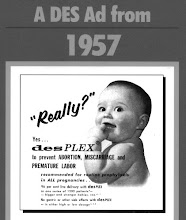Over four decades the great majority of an estimated 740,000 women prescribed DES during pregnancy and their children exposed to DES in the womb have been unaware of the danger of DES. Consequently they have been missing out on information about the vital special health care for their increased risks of clear cell adenocarcinoma of the vagina/cervix (CCA), breast cancer and other reproductive problems.
"A better understanding of the DES health condition and how this issue came to fall off the radar of health authorities and medical professionals will help major women's groups realise the importance of addressing the problems experienced by the Australian DES exposed population, the majority of whom are women," says group coordinator, Carol Devine.
It is common for the group to receive phone calls from women who have suffered the effects of DES without knowing why, and are only now learning about the harm caused by DES and the rightful health care they need through the group's own media efforts. Last year the New England Journal of Medicine revealed women exposed to DES in utero are at an increased risk of at least 12 adverse health conditions - in some cases up to three times that of other women.
Researchers are still following the health of the DES exposed population to determine whether other health problems occur with age and whether subsequent generations are affected. Women's groups interested in information can contact DES Action Australia-NSW, c_devine@bigpond.net.au / 02 9875 4820.
From National Cancer Institute USA.



3 comments:
The most frightening statistic isn't the 40 fold increase in vaginal cancer it is the 1.8 increase in breast cancer for women in their 40's.
Although still low at only 4% vs 2% what does this tell us as women age since it essentially doubled their risk.. Does this mean that 1 in 4 DES exposed daughters will develop breast cancer vs the 1 in 9 we currently see in unexposed women?
To Anonymous:
This is a very interesting question and one which I had to take to DES Action USA. It is complicated. The upshot is that the 1.8 increased risk in DES daughters does not transpose to the lifetime risk ratio of 1:8 women in the general population. This is because the 1.8 increased risk relates to DES daughters between the ages of 40-50. For DES daughters there is not an equivalent lifetime ratio as for women in the general population. Until cancer rates in older DES daughters have been tabulated in studies will we know the lifetime breast cancer risk caused by DES exposure.
Post a Comment